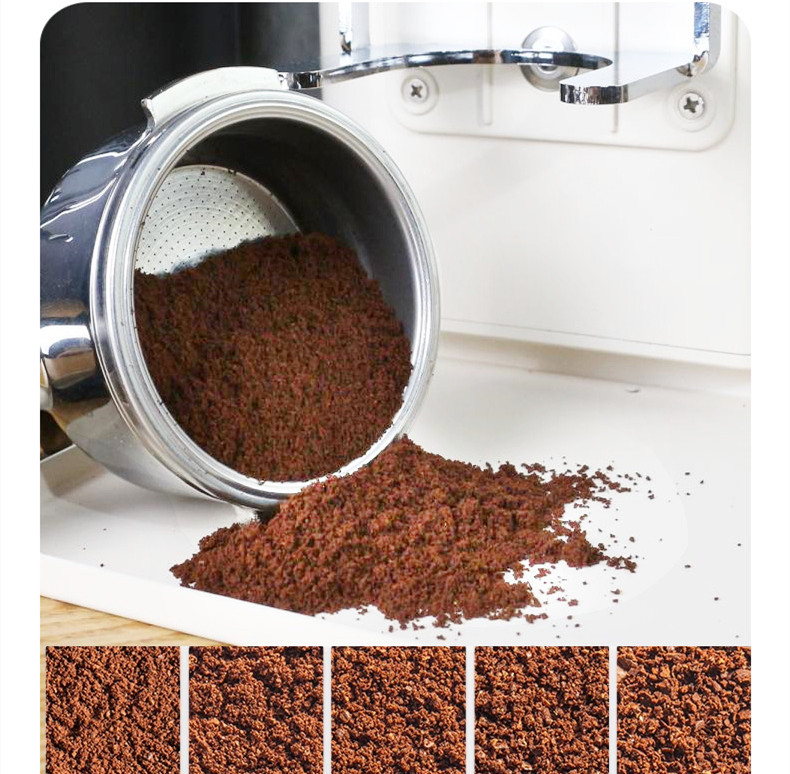The range of grinding degree adjustment is one of the core parameters for purchasing a coffee grinder, directly affecting whether the equipment can adapt to different brewing methods, meet personalized needs, and adapt to future technological upgrades. The following is a systematic analysis from three aspects: technical principles, applicable scenarios, and operation logic, and provides practical purchasing suggestions.
First, why is the range of grinding degree adjustment crucial?
Adapt to different brewing methods
The extraction efficiency of coffee is directly related to the degree of grinding. Different brewing methods have significantly different requirements for particle size:
Espresso: It needs to be ultra-finely ground (150-250μm), similar to the texture of flour, to withstand high-pressure extraction.
Pour Over: It requires medium-fine grinding (400-800μm), similar to granulated sugar, to balance the extraction speed and flavor layers.
French Press: It needs to be roughly ground (800-1200μm), similar to sea salt, to avoid bitterness caused by over-extraction.
Cold extraction/Mocha pot: Requires medium-coarse grinding (600-1000μm), suitable for long-term soaking or low-pressure extraction.
Conclusion: If the adjustment range of the grinder is insufficient (such as only supporting 5-10 Settings), it may not be able to cover all brewing methods, resulting in idle equipment or limited flavor.
Match the characteristics of coffee beans
Roasting degree: Light-roasted beans need to be ground more finely (to increase the extraction rate), while dark-roasted beans need to be ground more coarsely (to avoid burning and bitterness).
Origin and variety: Ethiopian beans may be better ground slightly to highlight the floral aroma, while Brazilian beans are better ground slightly coarsely to balance the sweetness.
Freshness: Freshly roasted beans release a lot of gas, so the grinding degree should be appropriately adjusted to avoid clogging the filter paper.
Conclusion: The adjustment range of grinding degree needs to be flexible enough to cope with the characteristic differences of different beans.
Support technological upgrade
As coffee-making skills improve, users may try more brewing methods (such as philharmonic and siphon kettles).
High-end players may achieve “flavor fine-tuning” by adjusting the grinding degree (just like a bean shows different balance of sourness and sweetness at different grinding degrees).
Conclusion: The wide adjustment range reserves space for future technological exploration and avoids frequent equipment replacement.
Second, how to evaluate the adjustment range of grinding degree?
Adjust the number of gears
Basic requirements: At least 15 to 20 levels of adjustment should be supported, covering mainstream methods such as Italian, hand punch, and French press.
Advanced requirements: Support stepless adjustment or subdivision of gears to achieve more precise control.
Adjustment mode
Step-by-step adjustment: Adjust step by step through knobs or buttons. It is suitable for beginners but has lower flexibility.
Stepless adjustment: Achieve unlimited subdivision by continuously rotating or fine-tuning the knob, suitable for professional players.
Scale system: Some high-end models use digital or alphabetic scales, which facilitate the memory and reproduction of parameters.
Adjustment range span
Minimum particle size: It should reach 150-250μm required for Italian concentration (which can be verified through the “finger rubbing test”).
Maximum particle size: It needs to reach 800-1200μm required by the French press (which can be verified through the “screening test”).
Uniformity: Within the entire adjustable range, the particle size distribution needs to remain stable (to avoid an imbalance in the ratio of coarse powder to fine powder).
Third, purchasing suggestions and a guide to avoiding pitfalls
Clarify the core requirements
Novice users: It is preferred to choose models with 15-20 steps of adjustment, which can balance ease of use and flexibility.
Advanced users: Choose the stepless adjustment or subdivision scale model, which supports fine-tuning of flavors.
Professional users: Choose models that support full scenario coverage to meet extreme demands such as competitions and commercial use.
Verify the authenticity of the adjustment range
Test method:
Set the grinder to the finest setting and rub the coffee grounds with your fingers. There should be no obvious granular texture (similar to flour).
Set to the coarsest setting, and the coffee grounds should be able to pass through an 800μm sieve (French press standard).
Avoiding pitfalls: Some models are labeled as “supporting Italian”, but in reality, the smallest speed still cannot reach 150μm, and this needs to be verified through actual tests.
Pay attention to the uniformity of adjustment
Test method:
Grind continuously for three times at the same gear, collect the coffee grounds and sieve them.
If the proportion difference between coarse powder and fine powder exceeds 10%, it indicates that the uniformity of adjustment is poor.
Avoiding pitfalls: Low-priced models may have significant fluctuations in particle size at the same gear level due to design flaws in the cutter head.
Avoid functional redundancy
If you only use hand-brewed coffee, there is no need to pay a premium for the “espresso level” (such as choosing a dedicated hand-brewed grinder).
If the main production is cold extraction, a model mainly for medium and coarse grinding can be chosen.
Fourth, Summary
The core logic: The adjustment range of grinding degree should cover the three mainstream scenarios of “Italian concentration – hand brewing – French press”, and reserve space for technical upgrades.
Priority sorting
Novice: Adjust the number of gears > ease of use > price
Advanced users: Uniformity adjustment > Adjustment method > Brand
Professional users: Full-scenario coverage > extreme performance > after-sales service
Tips for avoiding pitfalls:
The thinness of the Italian style is not up to par, and it’s hard to balance the thickness and fineness when rinsing by hand.
The gear position is falsely marked and needs to be tested in real time. Poor uniformity ruins the flavor.
By clarifying the requirements, verifying the parameters and avoiding redundancy, a suitable grinding machine can be precisely selected to prevent equipment idleness or flavor limitation due to insufficient adjustment range.


